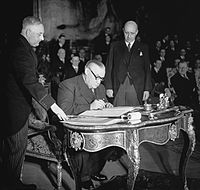Brussels Treaty
| Treaty of Economic, Social and Cultural Collaboration and Collective Self-Defence | |
|---|---|

Bevin, signing the treaty
|
|
| Type | Founding treaty |
| Signed | 17 March 1948 |
| Location | Brussels, Belgium |
| Signatories |
Belgium France Luxembourg Netherlands United Kingdom |
| Depositary | Government of Belgium |
| Language | English |
| Languages | English and French |
|
|
|
The Treaty of Brussels was signed on 17 March 1948 between Belgium, France, Luxembourg, the Netherlands and the United Kingdom, as an expansion to the preceding year's defence pledge, the Dunkirk Treaty signed between Britain and France. As the Treaty of Brussels contained a mutual defence clause, it provided a basis upon which the 1954 Paris Conference established the Western European Union (WEU). It was terminated on 31 March 2010.
The Treaty was intended to provide western Europe with a bulwark against the communist threat and to bring greater collective security. The Pact had cultural and social clauses, and concepts for the setting up of a 'Consultative Council'. The basis for this was that a cooperation between Western nations would help stop the spread of Communism.
In that it was an effort towards European post-war security cooperation, the Brussels Pact was a precursor to NATO and similar to it in the sense that it promised European mutual defence. However, it greatly differed from NATO in that it envisaged a purely European mutual defence pact primarily against Germany, whereas NATO took shape the next year, on the recognition that Europe was unavoidably divided into two opposing blocks (western and communist), that the USSR was a much greater threat than the possibility of a resurgent Germany, and that western European mutual defence would have to be atlanticist (i.e. including North America).
In September 1948, the parties to the Treaty of Brussels decided to create a military agency under the name of the Western Union Defence Organization. It consisted of a WU Defence Committee at Prime Ministerial level, and a WU Combined Chiefs of Staff committee, including all the national chiefs of staff, which would direct the operative organisation.Field Marshal Bernard Montgomery (UK) was appointed permanent Chairman of the Land, Naval and Air Commanders-in-Committee, with headquarters in Fontainebleau, France. The nominated commanders-in-chief were General Jean de Lattre de Tassigny (France) as C-in-C, Land Forces, Air Chief Marshal Sir James Robb (UK) as C-in-C, Air Forces, and Vice-Admiral Robert Jaujard (France) for the Navy, as Flag Officer Western Europe. Volume 3 of Nigel Hamilton's Life of Montgomery of Alamein gives a good account of the disagreements between Montgomery and de Lattre which caused much ill-feeling in the headquarters.
...
Wikipedia
